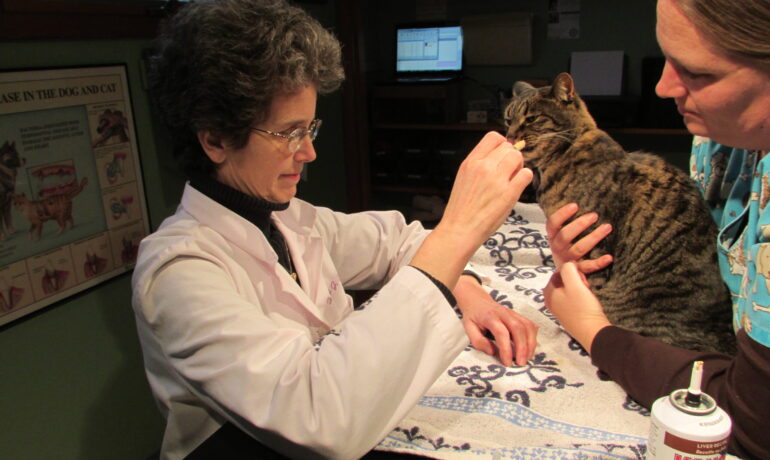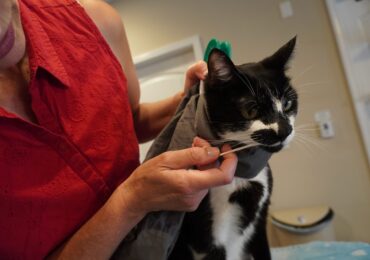The wonders of Witch Hazel (Hamamelis)

As I have grown in my expertise in reducing pet stress during care, I have paid attention to every item and every step of care. Decreasing noise, soft towels to insulate against the cold stainless exam table, and using rewards were some of the first items I kept consistent to provide less stressful care to my patients. One day, my tech clearly stated her cat hated the smell of alcohol as we were preparing to take a blood sample. I had not thought about the smell, sting, and purpose of alcohol as an antiseptic for venipuncture until that moment. Especially the effect on the animal who was receiving care – if it was another unpleasant factor, what could we use that would give the benefits of alcohol without the problems.
Isopropyl alcohol is in use everywhere in veterinary practice. It is part of the standard surgical preparation of the skin, for quick cleaning before vaccination or any other injection and for blood draw preparation. The benefits are many. It removes dirt, oils, residue cells and dries the skin making it unfriendly to bacteria and virus growth. The evaporation process helps dilate blood vessels, which is helpful for catheter placement and blood draws. Isopropyl alcohol is 70% alcohol and 30% water. The high alcohol concentration creates fast evaporation, which helps with blood vessel dilation. The evaporation of the alcohol is the “stink” or sharp smell sensation many cats find unpleasant. Ethanol that may be present in the alcohol, activates the vanilloid receptor 1 which causes the burning sensation (1). Small nicks from a clipper, irritated skin open these receptors to the alcohol adding to the unpleasant experience.
Ok, what would give the benefits of dilating a small blood vessel in a cat, clean the skin with some antisepsis, and avoid the “stink” and burn. I had a bottle of witch hazel on the shelf. Witch hazel is a common treatment for hotspots, rashes, and irritations. I knew it had alcohol in the solution so it would help to dilate the vein, making it easier to get the blood sample. I knew it did not sting, and I did not think it smelled bad so I grabbed the bottle. and suggested we give it a try. As we prepped the skin with the witch hazel, he did not pull away or react to the smell. The tech noted the procedure was much better for her cat. I started to use witch hazel for all our feline blood draws. With each cat, I saw how they were calmer, and did not squirm while prepping for a blood draw or catheter placement. I also noticed less grooming at the injection site, which is a good indication of less pain. I began to use Witch Hazel in place of alcohol for all injections, blood draws, and surgical prep in place of alcohol for both canine and feline exams, and was impressed at the additional reduction in patient stress.
What’s so wonderful about Witch Hazel?
Witch hazel is a shrubby plant, where the beneficial phytochemicals are extracted from the bark and leaves, into a distillate of water and alcohol This mixture, results in a 14% alcohol concentrate, containing the essential oils, tannins, and gallic acid – the phytochemicals that provide anti-inflammatory benefits and the alcohol antisepsis (2,3) Witch Hazel is far less sting, a woodsy odor, has a woody-like odor, and has very little if any sting over clipper burn or nicks. There was enough alcohol to dilate the blood vessels to help with a blood draw and catheter placement. Occasionally I would make a special bottle of half Witch Hazel – half Isopropyl alcohol to have more vasodilation when veins were collapsed. This blend helped raise the vein without the stink and sting. I also noticed less inflammation at surgical incision and IV catheter sites. This simple switch from alcohol to Witch Hazel eliminated many of the stress triggers, smell, and pain, increasing patient comfort. The cost for Witch Hazel is about the same as for isopropyl alcohol. There were not any cost savings with alcohol – the switch was simple to make.
In other forums, water, and chlorhexidine have been discussed as alternative site prep solutions. These products do not have an offensive smell so that helps. They do not contain alcohol and do not help with vasodilation. This can increase difficulty in venipuncture and may increase struggle. Chlorhexidine is one of the most antiseptic products available. I do not see a benefit to water outside of eliminating the smell and sting of alcohol. I suggest Witch Hazel over water as a site prep. Chlorhexidine is typically in a water solution – you could use the Witch Hazel as a first wipe prep, then use the chlorhexidine on the site for a final high antisepsis prep and get the benefit of both products.
You can purchase Witch Hazel at most grocery stores or pharmacies over the counter. It typically comes in a 16 0z bottle. We purchased small squeeze bottles to apply the solution to eliminate the wiping senation. I have also used small hand sanitizer bottles as a handy hands-free applicator. Avoiding wiping decreases irritation and pain sensation – just one more step to a less stressful care experience.

The last memory is the lasting memory
Every sensation, interaction, and environment cue create a lasting memory for our patients, with every care experience. The intensity of handling, a stinging sensation when injected, a loud noise in the room as the animal was in a cage, create a memory. Any pain stimulated, deepens the memory of the experience. Using topical anesthetics, switching out alcohol for Witch Hazel for alcohol, using a washable towel on the stainless steel table are small steps, that do not take additional time to use once you stock your work area, and provide a better memory. Every small step to reduce stress builds on the memory of a calming care experience. The small step of switching from alcohol to Witch Hazel is an important one to continue to build on the animal’s memory of receiving care. Changing the culture, techniques, and habits when providing care often requires witnessing the benefit. Try the Witch Hazel – observe the animal’s response to behavior and health. Take photos or document this to see the difference if it is not readily apparent to you or others.
There is a lot to learn when changing from traditional handling and care techniques. I found focusing on essential techniques, that are used on a daily basis is an easy way to build skills. I have broken down these essential techniques in my Top 5 Low-Stress Handling of cats and Top 5 Low-Stress Handling of dogs. courses. Consider taking these courses to create that lasting memory of low-stress and build a relationship with your clients and patients. Every day, with every animal we are creating the opportunity to build a better bond through better behavior.
Sally J Foote DVM, CABC-IAABC, LSHC-S
references :
- Why do antiseptics sting? https://www.livescience.com/57932-why-do-antiseptics-sting-on-cuts.html#:~:text=Ethanol%20activates%20the%20vanilloid%20receptor,in%20hot%20peppers%2C%20Glajch%20said. Accessed 2 25 2021 link
2. Witch Hazel Wikipedia page Accessed 2 25 2021 link
3. Link, R. MS 8 Benefits and Uses of Witch Hazel. https://www.healthline.com/nutrition/witch-hazel-benefits-uses Accessed 2 25 2021 link


